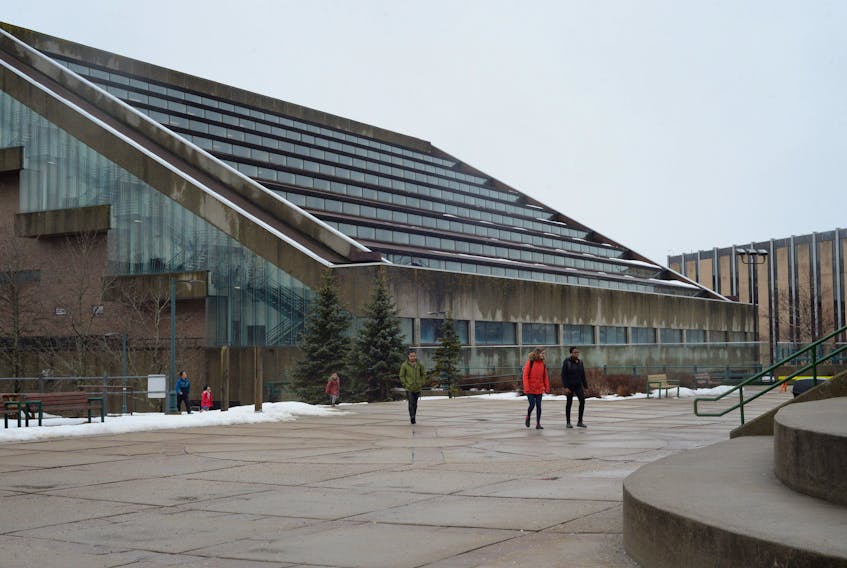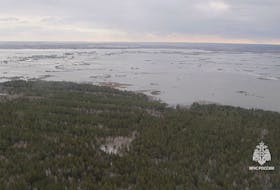Memorial University is in a financial bind, and president Gary Kachanoski believes it will have a dramatic impact with or without fresh cuts in Tuesday’s provincial budget.
“We have three simultaneous pieces, all of them with deficits, that is creating the, I would say, intense scrutiny around what is the sustainable solution going forward,” Kachanoski told The Telegram in a recent interview.
MUN faces a stagnant operating budget, a growing infrastructure deficit and mandatory special payments for its pension fund.
The estimate on MUN’s total budget gap for next year is $12.7 million.
And that will grow.
Related stories:
LETTER: Investing in education pays big returns
Landmark research funding benefits N.L., ministers say
That forecast does not include already planned job cuts through attrition: another $3-million worth of cost cutting is planned into 2019.
Throughout 2017 and into 2018, MUN’s leadership team conducted budget consultations and has been trying to decide where spending might be rolled back, and where more can be demanded from staff and students.
No final decisions have been made on how to handle forecasted shortfalls.
MUN also has to try to capitalize on landmark new investment in research and development by Ottawa, with billions announced for Canadian institutions. Much of that money is awarded through competitive processes through granting bodies. Researchers applying must prove they have the time, support and facilities to get the work done. They can’t risk a ceiling leak ruining experiments, or researchers being stretched due to unexpected layoffs. And MUN can’t expect big money to come its way without ambitious projects proposed by leaders in their fields, who look for compensation to match their qualifications.
In recent years, MUN has been successful in attracting more research funding and graduate students, while covering all areas of instruction dictated by the Memorial University Act.
One example of new funding is the Ocean Frontier Institute partnership with Dalhousie University and the University of Prince Edward Island. It’s a $100-million commitment, making it possible to leverage millions more.
But research funding can’t be diverted to help with general infrastructure, outside staff salaries or pensions.
Speaking with The Telegram by phone Friday, Advanced Education, Skills and Labour Minister Al Hawkins said the government is doing its best to support MUN’s operations during the province’s own period of financial constraint.
“We make a significant investment in the general operating of Memorial University and we do know there are challenges, and we’ve just got to maintain an open line of communication and we’ve got to work collaboratively together to find some of the answers to the challenges they have,” Hawkins said.
He credited MUN with attrition measures and spending reductions to date.

The tuition freeze
During any talk about MUN finances, tuition comes to the forefront.
Newfoundland and Labrador has become known for its low university tuition, particularly for Canadian undergraduates, and MUN’s rates are kept low in comparison to institutions across the country through directed grants from the province.
The “tuition offset grant” for 2017-18 was $56.4 million, up from $52.4 million in 2016-17.
But with the province’s financial challenges, will that tuition freeze get the same level of support in Budget 2018?
“I think we’ve been very clear we want to continue to provide affordable and accessible public education, post-secondary, public education to Newfoundland and Labrador students,” Hawkins said.
“That‘s a commitment that we’ve made and we will continue to provide that commitment, ensuring that domestic students have an affordable and accessible post-secondary public education system.”
Tuition for new graduate and international students at MUN is set to increase next fall, but remains well below the Canadian average.
All students started paying a $50 per semester student services fee, and a campus renewal fee of $50 per course for undergraduates (capped at $250 a semester) and $167 a semester for graduate students.
The Canadian Federation of Students (CFS) in Newfoundland and Labrador would like the province to put more into MUN than it has in recent years.
“We need the government to increase funding and reinstate the funding to our only university in the province,” CFS N.L. chairwoman Sofia Descalz told The Telegram Thursday.
- the same time, she said MUN’s administration might find a way to further cut expenses.
“It’s about working together to find a solution, but the solution is not downloading the cost of education onto students. The solution is not burdening our youth with a massive student debt,” Descalz said. “We’re seeing that in Canada right now, that we have $28 billion of student debt. That’s an all-time high. So, raising tuition is never the answer. That’s not going to fix the issue, it’s just going to create longer-term problems that will come back to us.”
The provincial budget comes down Tuesday. Subsequent decisions in May by MUN’s board of regents will settle what happens with tuition.
The tuition freeze was announced in 1999 under the Liberal government led by Brian Tobin and sustained through the subsequent Liberal and Progressive Conservative regimes.
The student federation believes tuition could be completely done away with. But that plan has yet to gain any traction with decision-makers.
Millions due to pension fund
The university has also been tackling pension reform.
Negotiations with unions around pension models are ongoing. That’s in addition to, and separate from, ongoing contract negotiations.
Regardless of how it shakes out, the university will have a big bill, or a really big bill, tied to pensions beginning this fiscal year.
MUN’s pension plan has an unfunded liability that needs to be addressed.
Unless there’s indication of a new agreement on pensions within weeks, the province — also the underwriter — has said a previously waived special payment by MUN (the employer) will be due in full.
Last estimates put the required payment at over $28 million a year, for the next 15 years.
A new agreement could essentially offer a reset, allowing the university to amortize over a longer period, reducing required payments to about $8 million per year. The exact figure would depend on the markets and final numbers at the time a deal is made.
The pension plan was once overfunded and remained close to 100 per cent in the late 1990s and as recently as 2007.
It was knocked back by the financial markets in the global economic downturn and then hit by the long-term implications of salary hikes.
Kachanoski said salary increases flowed from increases in public-sector wages.
Increases in compensation for administrators, faculty and researchers were needed to remain competitive, he added.
There was also hiring to support government-encouraged expansions in engineering, the medical school and the Marine Institute.
The last available “sunshine list” released by the provincial government shows MUN — including the Marine Institute and Grenfell Campus — paid 1,065 people total annual compensation of more than $100,000 each in 2016.
While the employee count is a complex one, estimates say MUN employed roughly 3,810 people this time last year, down from 3,895 the year before.
The count includes permanent and contractual employees, and counts anyone with both an academic and administrative role just once.
Infrastructure
Beyond compensation, the university has to ensure MUN infrastructure remains safe and sound.
“Our infrastructure is at that stage in many places when tunnels are at the point of collapsing and you have safety issues,” Kachanoski said.
As an example, he cites the pedway that once connected two buildings across Prince Philip Parkway. It was torn down instead of repaired or replaced.
“What’s happening is the buildings are telling us we need to spend on it. They’re forcing us to spend on it,” he said.
The university is responsible for most of the roads on the campuses, along with plumbing, water lines, electrical, telecommunications, standard maintenance for over 100 buildings, a small steam heating plant and more.
More than half of MUN’s buildings are over 40 years old.
Replacements mean announcements with fanfare, but are not always what they seem.
The new core science building in St. John’s, for example, was announced at an estimated $325-million value.
It will require $200 million to be covered by the university in the form of a $10-million-a-year mortgage payment. MUN has to find a way to cover that bill.
Kachanoski said the university was at risk of losing its ability to work with animals for research based on the state of its animal care building in St. John’s. The building is being replaced at a total estimated cost of $35 million. Of that, about $14 million is coming from the federal government. The rest is coming from MUN.
“We are taking a mortgage to pay the rest of it. And that’s an internal budget cut, if you want to say it,” he said.
“It’s not a budget cut from government’s perspective. It is an internal reallocation bill I can’t get around.”
ABCs, 123s
In a 2014 report, then auditor general Terry Paddon talked about MUN’s operational funding more than doubling over the previous nine years, plus a changing staff-to-student ratio with more faculty hires.
Paddon recommended the province review several things. Among them: how the university is funded, the tuition freeze policy and long-term planning for covering costs associated with aging infrastructure.
In 2017, then advanced education minister Gerry Byrne criticized the university after public debate that the tuition freeze might have to change as a result of MUN’s financial challenges.
The university made its provincial Budget 2018 submission in October.
The government’s own consultations for Budget 2018, beginning in December, included graphics offered to spur public response.
One of those, still available on the government’s website, is on post-secondary education funding. It notes provincial funding to MUN increased by 104 per cent from 2004 to 2017.
“The provincial government subsidizes almost 80 per cent of MUN’s operating costs,” it states.
“It will be important to consider how the university uses its operating grant, within the context of the province’s fiscal realities.”
A separate section on “taxpayer impact” notes spending on Memorial University amounts to about $1,500 per personal provincial income tax filer (health care was noted as $10,000 per tax filer).
Post-secondary education funding, including money for the College of the North Atlantic, amounted to about 8.4 per cent of provincial spending in the last year, coming in after spending on K-12 education, health care and public debt.
Kachanoski said he understands the situation the province is in.
He also said he cannot say what comes next for MUN.
“We cannot run a deficit on our operating budget. We cannot run a deficit on our pension. That needs to be solved. And for some reason, others believe we can keep running our infrastructure into the ground and run a deficit on maintaining our buildings, but we do not believe we can,” he said.
“For us, all three of those deficits are real and impact the quality of the education that we give students.”
(NOTE: Updated to clarify that tuition increases for new international students and Canadian students not from Newfoundland and Labrador were announced in spring 2017, but will apply in fall 2018, barring change.)









